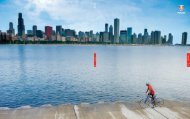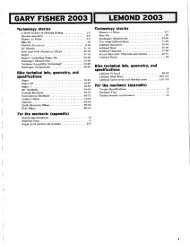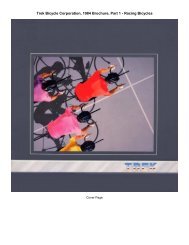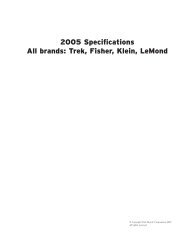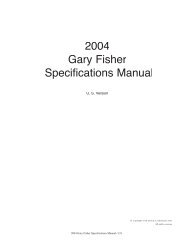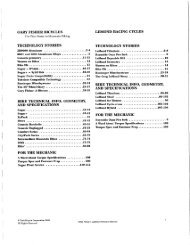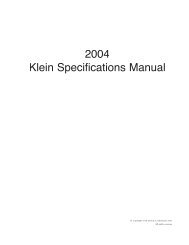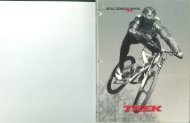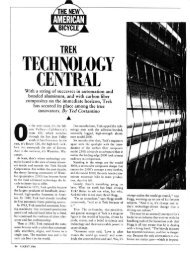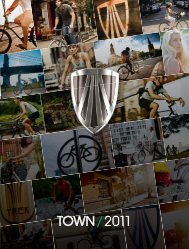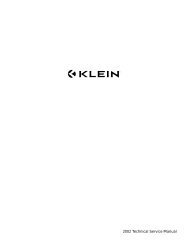TECHNOLOGY STORIES BIKE INFO, GEOMETRY ... - Vintage Trek
TECHNOLOGY STORIES BIKE INFO, GEOMETRY ... - Vintage Trek
TECHNOLOGY STORIES BIKE INFO, GEOMETRY ... - Vintage Trek
Create successful ePaper yourself
Turn your PDF publications into a flip-book with our unique Google optimized e-Paper software.
Good fit defined<br />
A rider pedaling a bicycle touches the bike in three<br />
places; pedals, saddle, and handlebars. For the bike<br />
to fit properly, these three points must interface with<br />
your body in a comfortable and functional way. In other<br />
words, if the saddle, pedals (and shoes), and handlebars<br />
(plus grips and controls) do not fit your feet, hands and<br />
seat, the bike won’t work its best for you.<br />
The three points of contact must be oriented correctly<br />
for you to benefit. Properly oriented, your muscles will<br />
work at their optimum. No muscles, ligaments, or tendons<br />
will be strained. Aerodynamic drag will be at a<br />
minimum.<br />
In addition to the relatively simple task of accommodating<br />
your body for comfort, the bike should ride<br />
better. Your center of mass should be positioned over the<br />
bike to accentuate your pedaling power while also balancing<br />
you over the wheels for the best bike handling.<br />
Put more simply, good fit results in your feeling completely<br />
relaxed on the bike over long periods of time. If<br />
your bike fits well, you should not feel like you need to<br />
squirm around, nor should you have excess tension in<br />
your shoulders, arms, or anywhere else. Basically, you<br />
should be comfortable, first and foremost.<br />
How performance effects fit<br />
The higher the performance level of your riding, the<br />
greater the forces applied to the bike, and thus to you.<br />
Forceful riders press harder on the pedals. They corner<br />
harder, and when riding off road their extra speed generates<br />
higher forces when they hit bumps. The forces<br />
applied to you on the bike are the result of a Newtonian<br />
law that states all actions have equal and opposite reactions.<br />
When you are riding, higher forces demand better<br />
fitting if comfort is to be maintained.<br />
However, in some cases greater forces may be found<br />
when your are riding less forcefully. If you are not<br />
pressing firmly on the pedals, you’re not lifted by the<br />
pedals. As a result, the casual rider often applies their<br />
entire body weight to the saddle.<br />
Regardless of the level of your riding, our definition<br />
of good fit holds true. Every rider should use the least<br />
muscle energy possible to support themselves on the<br />
bike, to stabilize themselves on the saddle, and to apply<br />
power to the pedals. To be relaxed requires that you be<br />
as comfortable as possible.<br />
Fit info in this Tech Manual<br />
On the specifications page for each bike model, we<br />
have listed the Fit items for that model, including the<br />
lengths, angles, or widths of the handlebar, stem, crank,<br />
and seatpost.<br />
Rider Height<br />
In addition to the measurements of the hard parts, we<br />
list Rider Height. This dimension is the median height<br />
of the average rider who might fit this bike in an average<br />
way, with its handlebars at their highest position.<br />
That’s a lot of qualifiers, but the information can still be<br />
valuable in helping you quickly fit a given model. Some<br />
models do not include Rider Height, either because that<br />
model offers too much fit adjustment to be defined, or<br />
simply because it’s a one-size-fits-all. So here’s all those<br />
qualifiers explained.<br />
Median Height- Different bikes offer different ranges<br />
of fit. Generally, the more bent over you are, the more<br />
noticeable a poor fit. Most bikes fit a range of heights.<br />
<strong>Trek</strong> 2002 Tech Manual<br />
Bike Fit<br />
Different bikes will have a different range. We have not<br />
attempted to define how wide the fit spread is on a<br />
given model; the variables are too many. Instead, we<br />
have listed the median, or middle. In other words, if we<br />
say a bike fits someone 70” tall it may fit someone from<br />
69 to 71”, or possibly (depending on the model) with a<br />
wider range from 67 to 73”.<br />
Average rider- When we design or spec a bike, we<br />
have a certain style of riding in mind. As an example,<br />
when we spec a 8500, we’re expecting that the bike<br />
will be either ridden by a racer, or someone who likes<br />
to ride like a racer. That doesn’t mean you can’t ride<br />
a 8500 on the bike path. But someone buying a 8500<br />
exclusively for bike path riding isn’t riding in an average<br />
way for that model, and will likely want to tune the<br />
fit to their purposes.<br />
Average Fit- We’ve studied a lot of riders over the<br />
years, and we can draw some conclusions about the<br />
way a bike fits the average person. But some folks<br />
aren’t average. Those with specific preferences, injury,<br />
or other abnormalities may require or prefer a nonaverage<br />
fit. As examples, consider two people of the<br />
same height but different weight. At 6’ tall, a 130<br />
pound person will sit on a bike differently than someone<br />
also 6’ tall who weighs 260. Incidentally, neither of<br />
these folks would fit our definition of average.<br />
Highest handlebar position- We made these fit estimations<br />
with the stem at its highest point. With Ahead<br />
stems, that means all the spacers were under the stem.<br />
With quill stems, the handlebars reach their maximum<br />
height with the stem pulled up to the minimum insertion<br />
line. With adjustable stems, it’s calculated with<br />
the stem at a 40 degree angle. Lowering the bars, or<br />
changing the parts, changes the fit of the bike as well<br />
as its Rider Height.<br />
13




